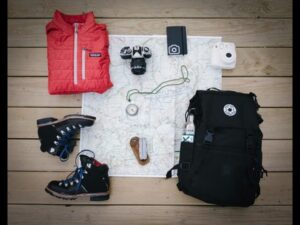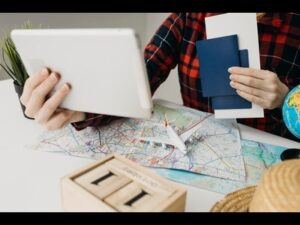Picture this: You ditch the city noise for beautiful, verdant surroundings. There’s a picturesque waterfall amidst the mountains and tall pine trees swaying in the air. That’s the charm of backpacking outdoors.
This backpacking guide for beginners will answer all your questions. We have tried to cover every aspect, starting with backpacking basics, transportation, budgeting, things to carry, and some insider tips, followed by FAQs.
What is backpacking?
Backpacking is a type of hiking where you carry all your gear with you for an overnight trip or longer. It includes stuff like sleeping bags, tent, food, water, cooking supplies, first aid kit, and other essentials that you might need on a hiking trip. Backpacking adventures help you rejuvenate, enjoy nature, and get some exercise.
How to Choose an Easy Backpacking Destination?

If you want to have an enjoyable beginner backpacking experience, you must take into account several factors:
- Distance – Shorter trails are the easiest. As a thumb rule, 5-8 miles round trip is good for amateurs. Note that carrying a backpack makes a seemingly easy hike much more challenging.
- Elevation gain – Steep climbs can be exhausting, especially with a full pack. So, if you are looking for easy backpacking destinations, go for elevation gains less than 1000 feet.
- Terrain – Uneven terrain with lots of rocks, roots, or streams can make backpacking for beginners tough. Pick a trail with a well-maintained, smooth path.
- Location – Pick a destination that is comparatively close to home. So, if something unexpected happens during backpack camping, you are not far from help.
- Climate – Plan your backpacking trip when the weather is pleasant and predictable. Avoid extremes of heat, cold, or rain if you want to go for an easy backpacking trip.
When I started backpacking, my first trip was to the Great Smoky Mountains National Park. It was a great experience as there are several well-maintained trails and scenic campsites. It just bowled me over and made me look forward to backpacking like never before.
How to Choose Essential Backpacking Gears?

The right backpacking gear is crucial for a comfortable and safe adventure.
Here’s everything you must carry in your backpacking gear.
-
-
Tent
-
Buy a lightweight backpacking tent that keeps you safe outdoors. Look for features like good ventilation and easy setup. Consider a 2-person tent for solo travel or a 3-person tent for sharing with a friend.
-
-
Sleeping Bag
-
It is advisable to select a bag with a temperature rating suitable for the hiking season and location. A mummy sleeping bag is a space-saving option that offers warmth. If you are planning a backpacking trip in wet terrains or rainy weather, go for synthetic fill.
-
-
Sleeping Pad
-
A sleeping pad provides insulation from the cold ground. Inflatable sleeping pads are lightweight and pack down small.
-
-
Clothing
-
Base Layer
– Carry quick-drying, breathable base layer clothing made from moisture-wicking materials like merino wool or synthetic fabrics to stay comfortable.
-
Hiking Clothes
– Take convertible and versatile hiking pants and a breathable hiking shirt.
-
Insulation Layer
– A fleece jacket or puffy vest provides warmth on cooler mornings or evenings.
-
Rain Gear
– Pack a waterproof rain jacket and pants for unpredictable weather.
-
Hat and Gloves
– A warm hat and gloves will help you endure cold nights and higher altitudes.
-
Extra Socks
– As a best practice, bring an extra pair of comfortable hiking socks to prevent blisters.
-
-
Accordingly, you need to pick your gears as per weather to stay comfortable outdoors. One thumb rule to swear by is ‘pack light’.
-
-
Footwear
-
Invest in a good pair of supportive, waterproof hiking boots with good ankle support for uneven terrain. Brands like LOWA Boots and La Sportiva have some great hiking boots for men and women who are going for a backpacking trip for the first time. You can navigate to Summit Hut website to explore different types of hiking footwear.
Pro-tip: Go for half a size bigger boots if you have planned a winter backpacking trip and you are going to wear thick socks underneath.
Basic Backpacking Checklist
As a beginner, it would be a great idea to keep this backpacking checklist handy.
Backpacking Foods: Fueling Your Adventure

Choosing the right backpacking food is crucial for maintaining your energy levels and ensuring a happy, healthy trek. As beginner backpacking trips can get physically demanding, you must prioritize good nutrition during the trip.
It burns a significant amount of calories, especially if you are carrying a heavy pack and traversing uneven terrain. Proper nutrition makes sure that your body has the energy reserves to tackle long hikes, maintain a steady pace, and avoid fatigue. So, it is advisable to consume high-calorie, easily digestible foods throughout the day. It will keep your energy levels up and allow you to fully enjoy the journey.
Hiking puts stress on your muscles. Consume enough protein to repair microtears and rebuild muscle tissue. It will promote faster recovery and reduce soreness. This translates to better performance on the trail.
Proper nutrition is not limited to physical benefits. It can also influence your mental state. Taking carbs keeps you focused and clear-headed while navigating trails and making decisions. Skipping meals or dehydration can affect your ability to enjoy the excursion.
During backpacking, you are likely to get exposed to new environments and weather changes. Therefore, it is imperative to consume various nutritious foods rich in vitamins and minerals. They will strengthen your immune system and make you less vulnerable to common cold or other illnesses during the trip.
Packing nutritious food items will keep your body temperature under check and maintain electrolyte balance. It will also improve your overall wellbeing. This keeps dehydration at bay and prevents heat exhaustion too.
However, it is important to carry easy-to-digest foods and avoid heavy meals before strenuous hikes. Plan your meals and snacks in such a way that they keep you fueled throughout the adventure without being tough on digestion.
Food Items to Carry During Backpacking
Pack lightweight, calorie-dense foods that keep you energized while minimizing pack weight. Aim for food items that require minimal cooking or preparation on the trail. It is recommended you carry foods that won’t spoil easily and can withstand varying temperatures.
That being said, here are some suggestions for food items you can carry while backpacking.
-
-
-
Dehydrated meals
-
-
Dehydrated meals are convenient and tasty. You just have to add hot water for a quick and filling meal.
-
-
-
Energy Bars and Trail Mix
-
-
Perfect for on-the-go munching, energy bars and trail mix offer a quick burst of energy and essential nutrients.
-
-
-
Nuts and Seeds
-
-
Almonds, cashews, peanuts, pumpkin seeds, or a flavorful mix of all these nuts and seeds serve as powerhouse snacks. They are rich in protein, healthy fats, and fiber.
-
-
-
Dried Fruit
-
-
Dried fruits are delicious options to satisfy your sweet tooth and get a dose of vitamins and minerals.
-
-
-
Instant Oatmeal
-
-
Instant oatmeal is a classic breakfast choice that provides sustained energy and is easy to prepare.
-
-
-
Freeze-dried veggies
-
-
Lightweight and nutritious, freeze-dried vegetables add vitamins and flavor to your meals.
-
-
-
Cheese
-
-
Cheddar and parmesan cheese have a long shelf-life and are suitable for backpacking trips. They are rich in proteins and make the dishes tastier and satiating.
Pro-tips for Packing the Right Food Items
-
-
- Dehydrate your own meals at home for a more customizable and potentially cheaper option.
- Plan your portions well and pack just enough food for your trip.
- Pack a mix of carbohydrates, protein, and healthy fats in your meals for lasting energy release.
- Carry diverse food items for breakfast, lunch, dinner, and snacking to prevent taste fatigue.
- Don’t forget hydration and pack enough water purification tablets or a water filter to stay hydrated throughout the day.
-
Planning Your Backpacking Trip: From Dream to Reality

The foundation of a delightful backpacking trip is proper planning and choosing the right destination. If you are a beginner, choose shorter, well-maintained trails with gentle elevation gains.
Ask yourself these three questions:
-
-
- Are you a mountain person or a history buff?
-
- What kind of hikes match your travel interests?
-
- How many days can you dedicate to the backpacking trip?
-
Research the weather patterns and trail conditions for your chosen destination. Avoid places with extreme weather conditions,especially if you are a beginner. Weekend getaways are good to start with. Also, consider your fitness level before choosing the destination.
Research any necessary permits or regulations for camping and campfires in your chosen area. It is imperative to obtain permits in advance.
Some trails offer established campsites with amenities like picnic tables and fire rings.
As you are a beginner, it is a good idea to have offline maps or detailed topographical maps of the trail. Also, if you have experienced backpackers in your circle, ask them to accompany you. They can be your friend, philosopher, and guide during the trip.
Budgeting For Your Backpacking Trip
Consider the cost of essential gear like a backpack, tent, sleeping bag, sleeping pad, and cooking equipment. If it’s going to be a one-off trip, you can even consider renting gear to save on initial costs. Calculate transportation costs to reach your trailhead, including gas, public transportation fares, or parking fees at trailhead locations.
Backpacking meals should be lightweight, high-calorie, and easy to prepare. Research backpacking food options and estimate your daily food costs. Factor in permit fees, park entrance fees, or camping fees associated with your hiking location. Keep some extra cash as a contingency fund. It can come in handy in case of unexpected expenses like gear repairs, transportation charges, and additional food purchases.
Resources for finding affordable accommodation and transportation

Given below is a list of different accommodation and transportation options
-
-
- Hostels: A classic choice for budget travelers, hostels offer dorm beds or private rooms at a fraction of the price of hotels. Popular options include:
- Hostelworld
- HostelBookers
- European Youth Hostel Association: (if traveling in Europe)
- Couchsurfing: This platform connects travelers with locals who offer a free place to stay (a couch or spare room) and cultural exchange. Couchsurfing: is a great way to immerse yourself in the local culture and save money.
- Housesitting: Websites like TrustedHousesitters: and MindMyHouse: connect homeowners with travelers who can house sit and pet sit while they’re away. You get free accommodation in exchange for taking care of the house and pets.
- Camping: Camping is a fantastic budget-friendly option, especially if you’re traveling by car. National parks, state parks, and private campgrounds offer campsites with varying amenities. Research and book campsites in advance, especially during peak season. Here are some resources for finding campsites:
- National Park Service campgrounds
- State park websites (each state usually has its own website with information on camping)
- Private campground directories like The Dyrt:
- Accommodation Booking Websites: While these often focus on hotels, you can sometimes find good deals on hostels, guesthouses, and apartments. Look for filters on search engines to narrow down results by price and property type. Here are some popular options:
- Hostels: A classic choice for budget travelers, hostels offer dorm beds or private rooms at a fraction of the price of hotels. Popular options include:
-
Transportation

-
-
- Buses: Buses are often the most affordable option for long-distance travel, especially between major cities. Popular long-distance bus companies include Greyhound (US) and FlixBus (Europe).
- Trains: Trains can be a comfortable and scenic way to travel, though not always the cheapest. Look for discount rail passes if you’re planning on doing extensive train travel in a particular region.
- Ridesharing: Ridesharing apps like Uber and Lyft can be a good option for short trips within cities, especially if you can split the fare with fellow travelers. However, be mindful of surge pricing during peak times.
- Flights: Budget airlines like Spirit Airlines (US), Ryanair (Europe), and Jetstar (Asia) offer cheap flights on certain routes. Be prepared for baggage fees and other add-on costs. Search for deals and be flexible with your travel dates for the best fares. Flight aggregator websites like Google Flights: and Skyscanner: can help you compare prices across different airlines.
- Hitchhiking (with caution): Hitchhiking can be a very affordable way to travel, but it’s important to prioritize safety. Only hitchhike in safe areas and with trusted companions.
-
Also Read This: The Best Satellite Messengers of 2024
General Tips
-
-
- Travel in the Shoulder Seasons
-
Traveling during the shoulder seasons (spring and fall) can save you money on both accommodation and transportation compared to peak tourist season.
-
-
- Consider Alternative Destinations
-
Popular tourist destinations tend to be more expensive. Research lesser-known places that might offer similar experiences at a lower cost.
-
-
- Be Flexible
-
Being flexible with your travel dates and itinerary can open doors to better deals on flights, accommodation, and transportation.
-
-
- Utilize Public Transportation
-
Public transportation options like buses, trains, and subways are often a cheap and efficient way to get around cities. Purchase travel passes for multiple rides if available.
-
-
- Walk Whenever Possible
-
Walking is not only good for your health, but it’s also the most budget-friendly way to explore a new place. You’ll often discover hidden gems and local neighborhoods off the beaten path.
Insider Backpacking Tips and Tricks: A Cheat Sheet
As someone who is a regular backpacker, the most important tip that I want to share is: Be flexible. Backpacking can get exhausting for beginners. Expect sore muscles and challenging moments. But maintain a positive attitude and perseverance throughout the trip. Take breaks to appreciate the surroundings and connect with nature. Keep away from technology as far as possible and keep yourself engaged with a lightweight book or journal during downtime at camp.
Investing in comfortable hiking boots will go a long way in making the hiking experience pleasurable for you. Give enough break in period to avoid any discomfort from the hiking boots. Choose durable, comfy, and weather-friendly clothes. If you are too picky about cleanliness and hygiene, carry a water filtration system or purification tablets to ensure safe drinking water throughout the trip. Also, choose a destination that has well-organized campsites. Hiking can get difficult for you if you do not get the necessary amenities.
For people hiking in winters, it is a great idea to stuff your spare clothes inside your sleeping bag for extra warmth. Keep a small deck of cards for entertainment after hiking during the day. Once you are back at the campsite, change into fresh socks, air out your boots, and address any blisters or injuries.
Pro-tips to Make The Most Of Your Adventure
-
-
- Pack light and avoid carrying any heavy-weight luggage on the trip.
- Keep a lightweight clothesline to air out damp clothes or wet socks at camp.
- Pack essentials like toiletries, snacks, or a change of clothes in Ziplock bags to protect them from moisture and bugs.
- Practice responsible camping etiquette to minimize your impact on the wilderness.
-
FAQs
How can I make backpacking easier?
Invest in a well-fitting backpack with lightweight gear. It is a good idea to pack your backpack and practice walking around with it. Go for regular hikes to get used to it. Once you have hit the trail, maintain a moderate pace and stay hydrated. You can use trekking poles for better balance and reduced impact on your knees, especially on descents. Making backpacking easier and enjoyable is all about strategic planning, staying alert on the trail, and following proper hiking etiquette.
What do I need to know before backpacking for the first time?
If you are backpacking for the first time, you must select a short, well-maintained trail. A 5-8 miles round trip with gentle elevation gain is great to start with. As you have no prior experience, go for established campsites with necessary amenities. Research well and obtain all the permits that you would need. Lastly, follow your gut feeling and listen to your body. If needed, take frequent breaks.
What should I pack for my first backpacking trip?
It is natural to be nervous and confused about what to pack while going for your first backpacking trip. First thing is your backpack. Get a backpack that distributes weight comfortably across your hips and shoulders. Take a lightweight backpacking tent, a sleeping bag, and a sleeping pad too. Choose clothing and hiking boots according to the weather conditions and terrains. It is also advisable to carry water, some snacks, and energy bars along with you.
How long should a beginner backpacking trip be?
A short backpacking trip of 1-2 nights is perfect for beginners. It will not only allow you to experience the joys of backpacking but also give you an idea about how to set up a camp, cook outdoors, and hike in different terrains.
How much money do you need to be a backpacker?
The amount you need for backpacking varies according to your travel style, destination, permits that might be needed, and duration. If you are looking for budget backpacking, you would need around USD 50 per day. Mid-range backpacking requires USD 50 to 100 a day and it strikes the perfect balance between affordability and comfort. Luxury backpacking would cost USD 100+ per day as it covers several adventure activities too in addition to comfortable accommodation and dining.
Related Posts:
- Hiking Checklist to Prepare for the Next Adventure
- Best Hiking Shoes of 2024: Unveiling Our Top 5 Favorites for Men and Women
- 10 Best Men’s Clothing Brands to Turn Heads
- Best Hiking Clothes for Women: Essential Gear and Stylish Outfit Ideas
- Benefits of Hiking for Your Social, Physical and Mental Well-being
- Backpacking in Aravaipa Canyon